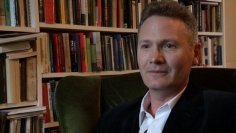LAURENCE REES: Moving onto the last few years of the war, how do you see the role of Albert Speer?
ADAM TOOZE: The grand continuity in Speer’s career is the triumph of the will. The triumph of the will is the slogan which in a sense answers your previous question. How the Germans succeeded in France in 1940 is not through tanks but through the triumph of the will. How they’re going to succeed in 1941 over these spectacular spaces and how they’re going to get to the Caucasus in one single blow is the triumph of the will. That’s how you see these pictures of the German army advancing across the Steppe with these individual, isolated figures with these tiny little tanks in this enormous space. This is nothing but the assertion of the triumph of German will over space and material obstacles. And what Speer enacts after 1942 is one demonstration after another on the factory floors of the Reich of that simple message: 'will' will triumph over material. And we will make out of Germany’s limited resources the quality of weapons and the quantity of weapons we need to allow our supreme fighting men to prevail in this war.
And they do it through a carefully stage-managed series of localised production triumphs, underpinned by statistics, which allow you to present a series of essentially PowerPoint slides of ever rising armament output. Speer has an entire team of PR experts working on slideshows that he can tour around the country showing. Speer is the first minister to pay any real attention to putting the armaments factories in the newsreels. They establish a liaison committee with Goebbels' Ministry to ensure that there’s armaments propaganda and that a whole series of individual weapon systems are surrounded with a mystique.
So it’s no surprise that the early German tanks are called boring things like Mark I, Mark II, Mark III, Mark IV, with the Mark IV being arguably the most important vehicle of the war, but the later versions have great big names like Panther, Tiger and so on. The mystique which surrounds even quite mundane weapons, like the new German machine gun which comes into operation in 1942, is deliberately cultivated to demonstrate how through these technical fixes, which are seen as expressions of German engineering genius and the relentless determination of the German workforce to enable their soldiers to win this war, will will triumph over circumstance. And that, I think, is the fundamental continuity in Speer’s experience. It’s not a strategic assessment of how Germany might be able to win the war or even a particular rationalising achievement; it’s the orchestration of a succession of demonstrations of this basic Nazi principle.
LAURENCE REES: So in that sense it’s an illusion?
ADAM TOOZE: Well, there’s no question that more weapons get produced during the course of the war, but if you take a modern economy like the German economy, at least in its industrial sector, and you give it single targets to achieve, any economy will display economies of scale; workers will get better at doing what they do if you reallocate resources as ruthlessly as Speer was doing. He actually shuffled them around between the priority armaments programmes, so one month tanks are the flavour of the month as they were, for instance, between the summer of 1942 and the spring of 1943, under the slogan ‘Adolf Hitler Panzer Programme’. All the priority programmes that subsequently followed acquire that tag, and they get the resources that the tanks used to be getting. So there is a real material substance to this, but it doesn’t add up to a productive achievement which is unlike that, for instance, of Britain and France, let alone that of the Soviet Union which is a true triumph of organisation and resource mobilisation which was much more spectacular in its dimensions than what the Germans achieved. What Speer does do is to package it and to shape this into a narrative.
The real gap between illusion and reality becomes evident only in 1944. Up to 1944 you have to say that when he announces a production record for tanks, that many tanks have actually been produced. In the autumn of 1944 the Speer Ministry actually finds itself in a position of lying, so what they do is they add extra weeks to the end of the last months of 1944 so as to be able to round off their curves and show sustained increase in output, even in the face of the military disasters and the ever increasing allied bombing campaign.
Albert Speer
Professor Adam Tooze

- Hitler and rearmament
- Germany’s new form of war
- German invasion of Britain
- German invasion of the Soviet Union
- The Nazi killing mentality
- Germany’s ability to win the war
- Albert Speer
- Why was WW2 so long?
- Greatest turning point of WW2
- Most mistaken decision of WW2
- Best decision of WW2
- Best leader of WW2
- The most overrated leader of WW2
- Why study history and WW2?
 Twitter
Twitter




